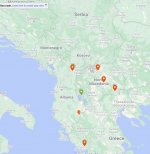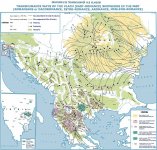torzio
Regular Member
- Messages
- 3,998
- Reaction score
- 1,250
- Points
- 113
- Location
- Eastern Australia
- Ethnic group
- North East Italian
- Y-DNA haplogroup
- T1a2 - SK1480
- mtDNA haplogroup
- H95a
Follow along with the video below to see how to install our site as a web app on your home screen.

Note: This feature currently requires accessing the site using the built-in Safari browser.
Well Malcolm argument against Daco-Thracian theory is not about generic compound words,Pointless, irrelevant comparisons. My point was compound words, not the arrangement of words.
Point being i can continue with other counter-arguments, but my reply was explicitly about compound words, and i was right.
Scholars like Schramm, Wilkes, Hauzinski, etc, point to this zone in central/north-Albania (from Shkumbin almost up to Lezha) that has place names ending in "-esh" (derived from Vulgar Latin. -esis) as being the original zone of settlement of the proto-Albanians in Albania.
This area coincides more or less with the ancient Arbanon region, and the expansion of proto-Albanians from this region would explain why this would become the ethnonym of both Tosks and Gegës later on.
Schramm argued that this distribution of toponyms terminating in -esh (Qyqesh, Gërdhesh, Zgërdhesh, Mollagjesh, etc) pointed to the area where Byzantium settled Bessi immigrants (proto-Albanians according to him).
He argued the settlement of Bessi immigrants in Arbanon explains why the Bulgarians were only able to open up access to the Adriatic south of Arbanon.

v

Well Malcolm argument against Daco-Thracian theory is not about generic compound words,
which every language has and why i called it comparing apples to oranges, but the structure of place names which are incompatible with Albanian.
Here is his quote to refresh every ones memory from the book:
https://archive.org/details/kosovo-a-short-history/mode/2up
Malcolm - "Kosovo a Short History" p.32:
-The strongest evidence, however, comes not from the meaning of the
proper names (which is always open to doubt) but from their structure.
Most Illyrian names are composed of a single unit; many Thracian ones
are made of two units joined together. Several Thracian place-names
end in -para, for example, which is thought to mean 'ford', or -diza,
which is thought to mean 'fortress'. Thus in the territory of the Bessi, a
well-known Thracian tribe, we have the town of Bessapara, 'ford of the
Bessi'. The structure here is the same as in many European languages:
thus the 'town of Peter' can be called Peterborough, Petrograd, Petersburg,
Pierreville, and so on. But the crucial fact is that this structure is
impossible in Albanian, which can only say 'Qytet i Pjetrit', not
'Pjeterqytet'. If para were the Albanian for 'ford', then the place-name
would have to be 'Para e Besseve'; this might be reduced in time to
something like 'Parabessa', but it could never become 'Bessapara'. And
what is at stake here is not some superficial feature of the language,
which might easily change over time, but a profound structural principle.
This is one of the strongest available arguments to show that Albanian
cannot have developed out of Thracian.

Discussing Dacio- Thracian after this, makes no sense. The whole base model has changed now.
Sent from my iPhone using Tapatalk
What makes no sense is that paper. They don't even make an argument or present any evidence archaeologically or dna-wise for their argument that albanian is some neolithic language.
Regardless, it changes nothing with regard to figuring out which language of the balkans albanian comes from.
It changes nothing. Hahahaahah.
Sent from my iPhone using Tapatalk
https://www.eupedia.com/forum/threa...ica-is-closing?p=669932&viewfull=1#post669932This clown never stop. He is now using even Çabej for promoting theories that have been debunked by Çabej himself.
https://archive.org/details/TheAlbaniansAndTheirTerritories
What makes no sense is that paper. They don't even make an argument or present any evidence archaeologically or dna-wise for their argument that albanian is some neolithic language.
Regardless, it changes nothing with regard to figuring out which language of the balkans albanian comes from.
Which haplogroups has Bruzmi claimed as Illyrian? In the part you highlighted Illyrians still retained control up to the Vardar river. Illyrians also retained control of the lake lands up until 334 BC when Cleitus and Glaukia lost to Alexander the Great in the battle of Pelion. That is not a short time. Moreover they regained control in the middle of the II century BC when in alliance with the Romans defeated the Macedonians.Of course Illyrians had their moment and experienced great successes, Cetina (proto-Illyrians) even had colonies in almost all parts of Italy which later had zero Illyrian presence. Are you going to lay claim to R-L151 Italics or you don't have any territorial aspirations toward Italy? It's very disingenuous to lay claim to haplogroups that have nothing to do with Illyrians because at one brief moment in time Illyrians passed through a certain territory. You might as well claim Illyrian top haplogroup was E-V13, because in present day Albania E-V13 is the leading haplogroup, and basically ignore the content and timeline involved. Just don't expect not to be called on the dishonesty. Brumi is a fraudulent character.
The paper you linked I have read a very long time ago btw, and it is just as I recall it. Illyrian rule was broken by the Cimmerians. Pay attention to what happened.

The only thing that I have changed my position on is the Iron Age Dardani were Illyrian and mostly R-CTS1450, their origins should be from the eastern Illyrian world, eastern Bosnia/western Serbia. These great Illyrian migration Hammond is describing in Macedonia and Korca region are lead by R-CTS1450, they ultimately go back to the Vatin variant that was assimilated into Illyrians during MBA. A twist of fate that the Illyrians that invade former R-BY611 territory(Brnjica) are themselves a Vatin variant. R-CTS1450 just can't stop itself from wanting to be in the center of the Balkans where the other Vatin derived cultures once lived.

Which haplogroups has Bruzmi claimed as Illyrian? In the part you highlighted Illyrians still retained control up to the Vardar river. Illyrians also retained control of the lake lands up until 334 BC when Cleitus and Glaukia lost to Alexander the Great in the battle of Pelion. That is not a short time. Moreover they regained control in the middle of the II century BC when in alliance with the Romans defeated the Macedonians.
From my point of view every Iron Age haplogroup in the extended Illyria of Appian(ie Yugoslavia + Albania + Thesprotia and Chaonia) is potentially an Illyrian.
For me the door for E-V13 is still wide open to be found in the Illyrian side of the Balkans during the iron age as the sampling is quite lacking. This is the map from rrenjet. I have added the Kamenica spot. https://www.google.com/maps/d/viewer?mid=1lKBWR3HpqtJlpCnbXGIN48Uxa2LwQ1Nq&ll=41.69294311620213%2C21.202201854687495&z=7
View attachment 13991
For me the door for E-V13 is still wide open to be found in the Illyrian side of the Balkans during the iron age as the sampling is quite lacking.
Well proto-albanians were ruled by Latin administration so the low greek loans is the expected result. Same goes for illyrians who were never ruled by the ancient greeks. For example proto-serbs/serbs have lived near albanians for 1400 years, yet they have low if at all albanian loan words. On the other hand they have a noticeable amount of turkish loan words even thought the time frame of contact was shorter an the distance longer.Yeah, it doesn't, since all the arguments about proto-Albanian (low greek loans, symbiosis with proto-romanians, etc) still hold true. It changes nothing for determining its pre-slavic and pre roman position.


Nimmt man als Ausgangsform für dieEntwicklung */Na.ís(s)os/(21) an, so hätten sich folgende Abläufe ergeben: */Nə.íʃə(h)/> */Nə.íʃə/ > */Nṑʃ(ə)/(22) > */Nṑʃ/ geführt, das die Quelle der slaw. Entlehnung seinkönnte. Es ergibt sich daraus, dass die Entwicklung der antiken Namensform zu jenerQuellform, aus der die slaw. Namensform entlehnt ist, durchaus und gerade nur mit alban.Lautentwicklungen vergleichbar ist. Jedoch kann bei der Beleglage nicht ausgeschlossenwerden, dass diese Entwicklung zu */Nīʃ/ (→ slaw./serbokroat. Nîš) letzten Endes einemregionalen Idiom zuzuschreiben ist, das nicht mit dem Albanischen identisch ist.*
This thread has been viewed 619298 times.
